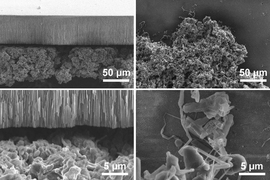Batteries, it seems, are everywhere these days, yet important questions remain about what kind of energy storage technologies are needed to help the U.S. meet its commitments to cut greenhouse gases and which areas of research are most likely to pay dividends by improving existing batteries or creating entirely new battery technologies.
After exploring these questions for the past five years, Jessika Trancik, Associate Professor of Energy Studies with MIT’s Institute for Data, Systems, and Society, has found some answers that she will share at “Materials for Electrochemical Energy Storage,” the Materials Processing Center’s Materials Day Symposium on Tuesday, Oct. 18. The symposium will be held in MIT’s Kresge Auditorium, followed by a student poster session in La Sala de Puerto Rico, Stratton Student Center.
“This year's Materials Day workshop will focus on advancing materials technologies for electrochemical energy storage, as well as on new systems-level approaches to cost-effective integration of these devices in both large and small-scale power grids,” says Materials Processing Center Director Carl V. Thompson, who is the Stavros Salapatas Professor of Materials Science and Engineering at MIT.
Dynamic models
Trancik developed dynamic models of battery technology and consumer demand in two areas with potential for large impact: electric cars and energy storage at solar and wind farms. Her key findings, published in Nature Climate Change and Nature Energy this past summer, are that:
• there is a window of opportunity for adoption of grid-level battery storage technologies for solar and wind electric generators at particular sites; and
• affordable electric cars available now could meet 87 percent of Americans’ daily driving needs with charging just once a day, for example, overnight.
“In some locations, for example, some stationary storage technologies available today add profit to solar and wind, and that’s taking into account the lifetime of the project and so forth,” Trancik explains. “In the next few years, there is an opportunity to do that at low cost with relatively little subsidy needed.” However, as solar and wind prices continue to fall, storage technologies will also need to become cheaper if they are to continue to add value.
Trancik, whose input was solicited by the White House ahead of the 2015 climate change negotiations, notes that commitments to the Paris Agreement, if met, will likely lead to significant growth in intermittent solar and wind installations. She says the next 15 years are critical for storage technology development. “By 2030, we really need to have developed affordable and well-functioning storage technologies in order to continue to support the growth of solar and wind worldwide,” she adds.
Similarly, with battery-based vehicles, such as the currently available Nissan Leaf, the outlook for converting a large portion of cars on the road from gasoline to electric looks promising. But, Trancik cautions, since electric vehicles have a shorter travel potential on a full charge than a gasoline car has on a full tank, a solution is needed for the 13 percent of cars on the road whose daily driving range would not be met. “There are a certain number of days during which the average driver will exceed that range. ... People buy and own vehicles to get them where they want to go on all days, not just 87 percent of days,” Trancik says. Some type of convenient, on-demand car sharing or other ways to meet these needs are critical, she suggests.
This year’s Materials Processing Center symposium speakers are:
• Kevin Eberman, product development manager at 3M;
• Jessika Trancik, associate professor of energy studies within the Institute for Data, Systems and Society at MIT;
• Boris Kozinsky, principal scientist at Bosch Research;
• Yang Shao-Horn, professor of mechanical engineering and materials science and engineering at MIT;
• Glen D. Merfeld, product science leader at GE Global Research;
• Yet-Ming Chiang, professor of materials science and dngineering at MIT; and
• Martin Z. Bazant, professor of chemical engineering and applied mathematics at MIT.
Bazant, who is executive officer of chemical engineering as well as professor of mathematics, will present his recent work on lithium-ion, lithium-air, and lithium-metal batteries. Recent findings in Bazant’s group uncovered two different ways that lithium deposits grow on the surface of lithium metal electrodes and showed how to effectively control destructive lithium filament growth at lower power levels.
“Energy storage devices are increasingly playing key roles in reducing carbon emissions through use in hybrid and all-electric vehicles, and they will have a key role in efficient use of both conventional sources of electrical power and power from clean intermittent sources such as solar and wind energy,” Thompson says. “These technology drivers have led to rapid advances in development of new materials and device concepts for electrochemical energy storage using batteries. This includes not just lithium-ion batteries, but also other metal-ion batteries, metal-air batteries and flow batteries.”
Registration for Materials Day is now open.


![“Researchers and practitioners have struggled to compare the costs of different [energy] storage technologies, because of the multiple dimensions of cost and the fact that no technology dominates along all dimensions," says Jessika Trancik, the Atlantic Richfield Career Development Assistant Professor of Energy Studies at MIT.](/sites/default/files/styles/news_article__archive/public/images/201606/MIT-Econ-Storage.jpg?itok=r4xFQ_wD)






